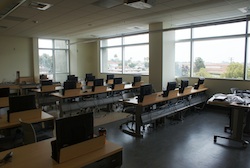Constructing the Perfect Design
 By: Tricia Hendrickson, FF&E Project Manager, Gafcon, Inc.
By: Tricia Hendrickson, FF&E Project Manager, Gafcon, Inc.
As Gafcon FF&E project manager, Tricia oversees all FF&E services in the renovation and expansion of three colleges and six continuing education campuses in the San Diego Community College District, a $1.5 billion construction program. Gafcon is the program manager for San Diego Community College District’s Propositions S and N construction bond program. For more information, visit www.Gafcon.com.
What comes to mind when you hear “furniture, fixtures and equipment”? An architect’s role in the creation of a new building is easy to visualize and understand, but what image does the phrase “furniture, fixtures and equipment” inspire?
Imagine taking a new building and flipping it upside down. Everything that’s not attached to the building and falls out is furniture, fixtures and equipment, or FF&E. FF&E can be one of the most important, yet most often dismissed, parts of a construction project. If not properly managed, it can cost clients thousands of dollars in change orders and increase the risk of overspending and delayed occupancy.
Today, school districts struggle to create best-value learning environments for students while complying with construction and design deadlines, and working within strict budgets. There are many decisions associated with school construction, including the building’s design and purpose, environmental and health issues, project cost, and unforeseen issues that can arise during construction. By the time most projects arrive at the FF&E stage, school officials have already invested so much time in the building’s design that they may not realize how important the outfitting of the interior is in creating the best learning environments.
Incorporating FF&E responsibilities into the program management function allows school districts to pull multiple disciplines into one source, delivering synergy and the best possible solutions. The FF&E project manager reviews the project at a macro level and works with the district’s procurement offices to forecast future procurement of items and leverage collective buying power. Implementing proactive front-end strategies such as vendor pre-qualification and standards development can preserve budgets and conserve valuable time. The program manager’s experience and knowledge of public contract codes and cooperative agreements helps the school districts save time and effort in selecting and procuring products that support the overall design vision.
 When FF&E falls outside of the program management function, the construction team will often discover towards the end of the project that the equipment does not fit the building’s infrastructure, because the design and construction teams didn’t communicate and collaborate effectively. Project managers smooth out the FF&E process by serving as a liaison between school officials and all project teams, helping communicate each partner’s needs. In addition, as the functionality of Building Information Modeling advances, the FF&E process will enhance the ability to design in digital space before installing furniture and fixtures in real space. This will help detect unforeseen problems with infrastructure coordination.
When FF&E falls outside of the program management function, the construction team will often discover towards the end of the project that the equipment does not fit the building’s infrastructure, because the design and construction teams didn’t communicate and collaborate effectively. Project managers smooth out the FF&E process by serving as a liaison between school officials and all project teams, helping communicate each partner’s needs. In addition, as the functionality of Building Information Modeling advances, the FF&E process will enhance the ability to design in digital space before installing furniture and fixtures in real space. This will help detect unforeseen problems with infrastructure coordination.
Technical jargon that doesn’t translate across sectors can also deter a project from fulfilling the district’s vision. Including FF&E service as part of the program management helps ensure communication is clear and consistent through all construction and design phases, eliminating pricey change orders.
The on-site project manager can assist in the delivery and installation process once the FF&E products are selected. Not executing this process properly can result in lost or unaccounted items, which increases costs in reorders and repairs. The FF&E project manager serves as the main point of contact and coordinates vendor schedules with the construction team to supervise installation, track punch list items, and schedule specialized electrical or infrastructure-related installations. The FF&E project manager can provide immediate, on-site support for this process, which saves time and money by preventing lost or stolen items, missed deliveries and relieves the districts from assigning staff to manage these final steps.
It’s the responsibility of FF&E providers to help clients meet their need for functional, comfortable, cost-effective and durable products that fit the intended design of the building, and are aesthetically pleasing. For most education clients, including school districts, the most important factor when it comes to FF&E objectives is cost efficiency, followed by longevity, functionality, warranty, maintenance and design aesthetics.
However, there are also multiple user-level parties that have their own set of interests and ideas. Faculty may want a cutting-edge classroom or learning environment fitted with the latest technology and materials. On the other hand, the facilities department responsible for the maintenance and care of the buildings will want materials that are cost-effective, easy to maintain, and provide a substantial return on investment in terms of life cycle costs. Unfortunately, durability and great design often do not go hand in hand. When integrated into the program management, an FF&E project manager can help the project team effectively leverage their expertise to meet expectations by identifying and evaluating products that will provide a timeless look and low maintenance requirements suitable to all parties.
With proper collaboration and a well-qualified team, education clients can create state-of-the-art facilities that maximize budgets to provide optimal teaching and learning environments, supporting the best interests of faculty, staff and students.
